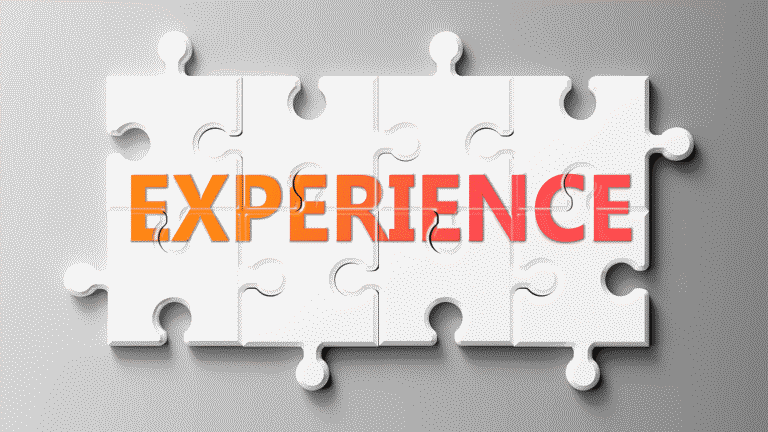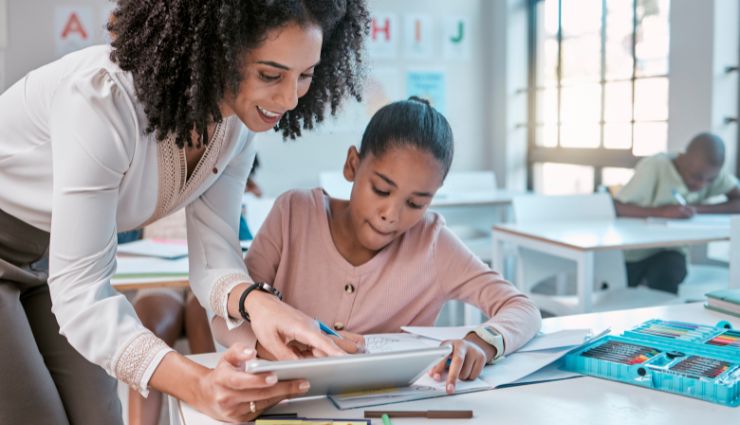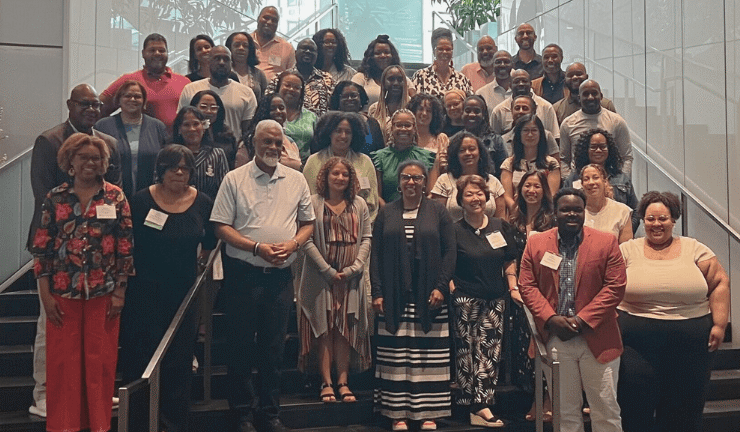An International Perspective on Innovation in Education

Editor’s Note: Having heard about the impressive steps that Graded: The American School of Sāo Paulo has taken in the past few years to elevate the teaching and learning process, we reached out to Graded’s Superintendent, Richard Boerner, to talk about the changes and their implications for innovation in all schools. Among other initiatives, Graded has entered into a partnership with Stanford University’s d.school to drive innovation in the curriculum. Through additional work with Dr. Kevin Mattingly, a cognitive science instructor at the Klingenstein Center at Columbia University’s Teacher College, and COGx, a research and development company in applied cognitive science, Graded is also incorporating new instructional and assessment strategies with the goal of helping all students learn deeply and develop lifelong metacognitive skills. To work with the faculty and help facilitate the transition, the school has also internally hired and trained four “deeper learning coaches.” What follows is an edited version of our conversation.
CS&A Staff: Part of the movement for innovation in schools today simultaneously seems to be a re-examination of mainstream education of the past 30-50 years — a looking back to figure out how to move forward in a more effective way. What do you see when you look back? What did we collectively get right and what clearly needs fixing?
Richard Boerner: There’s much that we’ve gotten right in the past 30 years regarding high-quality teaching and both formative and summative assessment. We just haven’t applied it widely enough. We erred in the 1990s and early 2000s when the focus in schools was fundamentally about driving only academic achievement, measured by various test results. It’s not all we did, of course, but we let it dominate our work in schools. In the process, we failed to be of service to the kind of deep learning that should be the essence of education.
At Graded and elsewhere, we’ve been rethinking the core question: Why do we go to school? The resulting conversations have been pushing schools to shift their programs in favor of helping students develop lifelong cognitive skills — develop one’s mind, one’s ability to think, to create, to collaborate, etc. At the rudimentary level, these essential elements of learning were lost even in how we trained teachers. When schools focus only on the achievement end of education, and not on the process of how one thinks, how one takes in and processes information, we are selling students short.
Ultimately, content-heavy lessons coupled with high-stakes measurements — SAT, ACT, IB, AP, etc. — have offered universities an easy way to calculate and rank students. That’s the main reason schools bought into this system. But we know we can and should do better.
The other stumbling block has been dealing with the anxiety and leeriness about change — especially when you’re changing something that, on paper, seems OK, and when parents have a choice about which school to send their kids to. So it’s understandable that schools have been cautious about rocking the test-prep boat. Fortunately that’s starting to change.
At Graded — and at other schools as well — we’re getting back to this central question of the purpose of education. But this time we’re also equipped with much greater knowledge about how children learn and how to teach in a manner that brings out the best in each child. Schools that see themselves as innovative today know they are on a better path than they were 20 years ago. But it’s still challenging. We need to be very clear about why we do what we do — so we can bring along all constituents in the process of building better schools.
CS&A: The word “innovation” is used widely now in education circles, but often with different notions of what innovation means. What does it mean to you and in context of the work you are doing at Graded?
Boerner: Essentially, we see innovation as a way to embrace the kinds of actions in education that can provide a profoundly better experience for all students, not just in school but also in all dimensions of life after school and college. In my mind, this is innovation because it’s asking us to focus on taking action in schools today whose results cannot be immediately known. In a way, we are placing a bet that the learning experiences students have today will in fact benefit their future self. This is a profound shift from the short-term, college prep thinking. The result of our work, while we want it to engage students in the moment and serve them well in college, ultimately manifests itself much later in their lives.
If we really want to measure the success of our students, we shouldn’t just measure them when they are 18; we should also measure them at 30 when they’ve taken all they’ve learned in school and have applied it to work and life.
At Graded, we’re conducting testimonial interviews with our graduates. If we’re doing our jobs right, our graduates should talk about the deep, rich, meaningful learning experiences in school and offer concrete examples of how the skills they have developed can be transferred in an array of uses. We want to know we’ve given them the skills to adapt, thrive, contribute, create, lead, succeed — and enjoy life. Our measure of success is that when they look back, they will say thank you for preparing them well.
Innovation isn’t about some radical new way of teaching or running a school. Yes, there are product innovations in educational technology that can be helpful and enable other changes. But innovation, to me, is about taking enough risk to do what really matters. It’s about taking the steps that get at the core of the school’s mission, to leverage all the knowledge about brain science and learning so that we help each and every student both succeed in school and in the complicated thing we call life.
Innovation is not about the tools. It’s not about improved test results. It’s not about the short-term goals. It’s not about the computer. It’s about the intellectual and emotional well-being of all students coupled with engagement and success now and in the future.
CS&A: You have written about the intersection of design-thinking and future thinking. These are complex concepts that aren’t always easy to wrap one’s mind around. Or perhaps it’s better to say it’s not always clear how the ideas behind these terms get translated into programmatic change in schools. Can you talk about how, at Graded, these concepts inform what you do?
Boerner: In all candor, I came at design thinking a tad cynically. I didn’t think of it as a gimmick or fad, but I thought of design thinking as simply a term that describes what great thinkers have always done. Our director of analytics, innovation and research, Shauna Hobbs-Beckley, pushed back on my thinking. She was the one who convinced me that we need to engage in understanding design thinking as it applies to education in general and infuse it into our conversations about improvements at Graded. To that end, four of our teachers have been trained at Stanford University’s d.school to better understand design thinking and to launch conversations here on how we can use it to address programmatic challenges. These faculty members have now become the creative catalyst in our discussions about change — about advancing the generation of ideas about teaching and learning. I think all of us have come to see that having an actual process has helped us a great deal in identifying core questions.
Personally, through my time at the Klingenstein Program at Columbia University in 2019, I have evolved my understanding about the intersection of the design-thinking process and education. In particular, Dr. Kevin Mattingly’s course on The Science of Learning encouraged me to think through all the issues and challenges related to quality education in the 21st century. Right now, at most schools, the core of learning is still content. We may supplement this content with conversations on how students learn and explore matters such as creativity, problem solving, critical thinking, social-emotional engagement and all. But if we say that the fundamental purpose of school is to have every student be thoughtful in their ability to learn deeply and be able to transfer that learning to a variety of circumstances, then we need to flip the paradigm — think of content as a vehicle toward a greater end.
But of course, that’s easy to say but really hard to do. How do you flip this paradigm? How do you physically set up your school so the content is the vehicle and not the end-product? How do you then reframe the way instruction is delivered? This is where design thinking comes in. The process has given us the strategies to tackle these big questions, which will ultimately reshape much of what we do at Graded.
So I consider the design-thinking process to be a lifeline. It’s something to draw on as we find our way through from where we are to where we want to be. It helps us articulate how we get from an idea to something tangible and applicable.
CS&A: And Stanford’s d.school has been helpful in this process?
Boerner: Absolutely. When we had to shut down the school in March due to the pandemic, we immediately reached out to the d.school for help. We already had a good working relationship, but this seemed an opportunity to accelerate our work. I was more or less placing a bet that we were not going to reopen until August, and that we could use the time to future-design a plan for reopening in a way that would incorporate the kind of changes we’ve been talking about. So in April we started building out our reopening plan for August. With the help of Ariel Raz and Laura McBain at the d.school, we went through umpteen prototypes, and today, actually, we’re doing a flight test of all of our new design elements. Next week, we open the high school at 50 percent capacity with these new initiatives.
CS&A: You’ve described this COVID-19 pandemic and the forced shut down of schools as a seminal moment forced upon us. How do you see the shift to remote learning driving key questions about schooling?
Boerner: For us, the advent of COVID-19 accelerated change exponentially. It forced us to reckon with a number of issues in our teaching and learning practices, particularly regarding content coverage. Ultimately, we came to understand that we need to slow down the day, teach less content, and help students go deeper into understanding and exploring the content we teach.
While the sudden shift to distance learning was tough all around, it turned out to be an opportunity for us to practice what we preach about improving education for deeper learning. We began to experiment in how we could use this time to support our early initiatives into deep and enduring learning. For instance, we experimented with different models in which some days students didn’t have synchronous lessons but would connect with teachers online to discuss their learning, to process what they were learning. And the feedback from students and teachers indicated that this shift in practice has been engaging and effective.
To better understand the experiences and outcomes, we also conducted fishbowl activities over the summer. We would sit with 10 or so students and ask them a series of questions. In turn, they talked about their experiences while the teachers listened. After 20 minutes, we flipped the table and put the teachers in the middle and asked them to talk about what they heard the students say. In the last 20 minutes, the students came back in the middle to correct the record and otherwise highlight what they want teachers to know about their learning experiences.
Interestingly, some of the students would say that they may have covered less content in their online classes in spring, but that they could recall information better and felt they were learning more deeply. Almost to a person they felt the learning experience much more vividly. That told us something about what kids were actually learning, what was sticking. And it raises the key question: Why do we work so hard to teach them a boatload of content if they can’t recall much of it three months later? Isn’t it better to focus on less content, but go more deeply into it so students remember and infuse into their thinking so they can use it in the future?
CS&A: What has been the impact of this experiment on the start of the current school year?
Boerner: When we reopened in September we pivoted our instructional approach to almost completely synchronous online classes in the upper school. This shift came with some significant rethinking of what the synchronous and asynchronous experience actually looks like. We consciously started with a different instructional model. In every block, students connect with their teacher, but we highly discouraged having students sit on Zoom for 80 minutes. The teachers are taking the best of what they do as educators and adapting it for the realities of a 2-D platform. A teacher may have kids go offline and write individually or have a pair of students get together and talk in a breakout room. Or they might help students individually for part of the class time. So if a class starts at 9 am, the kids may meet at 9 am, but then go off on their own or in small groups during the class period. The teacher bounces around and supports them. In some ways, this is not at all innovative. It mirrors what good teachers do in the classroom. But it’s also tremendously innovative in that we’re taking the time to identify best practices and putting it to use in a whole new platform. There’s no question that most of us prefer being in a physical classroom, but it’s been highly instructive to learn from the online platform how to identify flaws in teaching practices and work to improve them, for any platform. And when students return for in-class learning, we’ll continue this process of encouraging deeper learning.
At the same time, we’re trying to allow for constant feedback in the design process. It enables us to better understand what is working and what isn’t. Of course, the proof is in the pudding. But it’s good to see the way the process has enabled movement, has helped us to dive into the space that we’ve wanted to be in for some time now — a place where we really do get to reexamine what works and what doesn’t and actually make changes.
CS&A: Around 20 years ago, Dan and Chip Heath wrote Made to Stick, focusing on, among other things, how we can make learning stick in schools. We don’t hear many references to the book these days, but we see more and more schools focusing on this concept of stickiness — designing programs that enable deep learning, not for tests but for life. In your design process, how much do you focus on this question of stickiness?
Boerner: This is the foundation of our focus right now. We truly want to know what information and skillsets stick with our students and why. What we’re also trying to do is determine how we train teachers to prioritize this deep learning — and how we then translate it into student experience. The science of learning has been known for 20-plus years, but it has not been widely translated into classroom practices. We’re trying to get to a place where we’re clearly infusing brain-science learning into all classes and develop better ways of gathering evidence of student success. How do I translate the brain science of learning into, say, a third-grade classroom? What does the scientific term “productive struggle” mean to a fourth-grader vs. an eighth-grader vs. an eleventh grader? How do I leverage the concept of productive struggle in a way that enables all students to find their learning sweet spot — that place where they are challenged to learn and have intrinsic motivation to learn, where they are not overwhelmed or discouraged. We have this body of knowledge on all this and we want teachers to understand and use it well.
CS&A: Do you have a sense of how you’ll address the measurement of deeper learning?
Boerner: We’re interviewing some companies to help us better understand how to measure the outcomes of our deeper-learning initiative. The study we’re planning to engage in will not be an empirical double-blind study because we’re not going to not do this with some kids. But we can certainly look at data from pre- and post-study. The goal is to develop a highly useful assessment matrix.
Generally, we’re doing everything we can to get this change right. Dr. Kevin Mattingly is our science and learning advisor in this process. The Stanford d.school is helping us bring our resulting ideas up to scale — create a prototype of how we’re going to implement changes. And we have a third partner, COGx, that will help with developing a curriculum around the skill sets we want students to develop.
What is unique about what Graded is doing is that it’s not a coalition of the willing. It’s not something that we’re going to do just with high school kids. It’s not a lab site that addresses cognitive science on the side. We’re looking to transform teaching and learning across the whole school. We want to see if we can systemically transform what we are doing so that all students have deep learning experiences and, in developmentally appropriate ways, develop the metacognitive skills that will serve them well now and in the future.
CS&A: Resistance to change is always an issue. Part of that resistance may just be an unwillingness to try something new. But in many cases, teachers truly believe they are doing a good job and don’t think changing practices is right. How are you helping reluctant faculty in this transition period?
Boerner: As noted, we have trained four teacher as deeper learning coaches. Their job is to help all of their colleagues. Recently, our academic leadership team met with these coaches and we were working on designing what we call our North Star — that fixed point we are trying to get to. To be successful in this initiative, we need to be very clear about our goals and we need to be able to articulate them to our faculty and community. In the meeting, a member of the leadership team asked, “What’s the problem we’re trying to solve here?” In truth, there is no problem. We’re a good enough school. We have good enough results. We could do none of this work and we’d still be considered to be doing a good job. But I think there’s plenty of research that makes it clear we can do better — and why we should try.
Perhaps the best way to look at the drive for change in education is to use an analogy from another profession. If we were a group of surgeons and we were trained in a new methodology to conduct surgery in a way that would save more lives, and yet we chose not to employ those methodologies, it would be malpractice. Right? We should all be fired. If in education, we know there are ways in which students can learn better, learn more deeply, that this shift can transform their lives — and that there is already evidence that deep, enduring and transferable learning enhances student performance — if we chose not to it, that’s a kind of malpractice.
So… it’s almost like we don’t have a choice. We have to engage in the process. And I think all schools should do this. It gets to the core of why we are educating young people.
Now, teachers have to fundamentally believe this. They have to accept that some of their teaching doesn’t stick or doesn’t stick enough, and that there is a better way. That’s a bit humbling. But if the literature on learning can show evidence that these new approaches to teaching and learning are more effective, that they help things stick, then I think we have an argument to make. There is also a bit of a carrot for teachers here. COGx and Columbia University will collectively endorse and certify our teachers as cognitive science teachers. From a marketability standpoint, that couldn’t hurt an educator moving forward.
CS&A: It sounds wonderful that Graded has the attention and support of the d.school and Columbia University. But in the process, you must be asking your teachers to be far more public about what they do.
Boerner: Getting a faculty to have a common purpose and a shared belief about how to move forward together does mean we have to be more public about our teaching. Part of the challenge is setting up a new professional culture. We’re trying to do this with our learning coaches who connect with all teachers. We’re also holding 12 “Reflective Wednesdays” when we meet in small groups after school to reflect on our practice. Sometimes it’s a straight up conversation. Sometimes we’ll review a video of one of the teachers teaching and then dissect it through the lens of science and learning. We’re planning to also use this time to have our learning coaches lead conversations on a particular aspect of deeper learning. All of it is designed to continue the process of improvement.
Right before the pandemic, we did some demo videos with Dr. Mattingly. In front of the whole faculty he dissected the high school principal’s demonstration teaching. It was a phenomenal, rich experience. Afterward, we asked teachers if they’d be willing to have some of their classes videotaped and have the tapes shared in our Reflective Wednesdays. Eighty-two teachers agreed.
CS&A: Do you think you could have gotten to where you are today without the help of the d.school, Dr. Mattingly, and others?
Boerner: I think we could. But it would take us a longer time. And I’m not sure we could have done it as effectively as we have. Part of the value of the consulting support is simply confirming one’s hunching, quelling one’s doubts, having the courage to move forward. When you are trying to reimagine a school, that’s such a massive undertaking. So it really does help to have outside experts guide you, confirm your thinking, offer ideas, help work with constituents, and frame the process in a way that makes it possible to achieve.
Having someone training you in how to understand the design-thinking process is much better than stumbling along on your own, trying to figure it out. Now there are other organizations and folks who do this work with schools. But the valuable thing about Ariel Raz and Laura McBain at the d.school is the way they think. They obviously have a philosophy about how design works to implement change, but they are also educators and can be valuable critical friends, challenging and pushing us. Our partnership accelerated so much that from April through August we were meeting every Saturday for four hours with our entire leadership team.
As a side note, we’ve also opened a space called the Learning Lab. It is where our learning coaches and our teaching and learning department operate. Our goal is design ways to approach learning that are proven to be effective, then we want to both employ it in our school and push that knowledge and information out — provide a way to help other educators and schools here in Brazil and throughout the world.

The Learning Lab
CS&A: Sounds like you have a long to-do list.
Boerner: Yes. We are taking on a lot. And doing it all in particularly challenging times. But it really does feel like this is the time for looking as deeply as we can at what we truly want to achieve in all schools and how we can reimagine and reshape our programs to accomplish what are clearly increasingly important outcomes — for both individual kids and the society as a whole.
CS&A: Tools and challenges aside, research also shows that the teacher and student relationships are key. How does this fit into the work you are doing at Graded?
Boerner: The research is clear on this. Intellectual engagement matters, but identity, meaning and purpose matter even more. It’s so important that all students have a sense of who they are and of belonging to a community, a class. To understand the concept of belonging, we have to look at learning at the granular level. We talk about this all the time in our faculty meetings. Belonging means you feel welcome, you feel competent, you feel you can take risks. Fundamentally, if we don’t get belonging right, all the other stuff doesn’t much as matter.
It’s interesting to note that some students today are actually thriving in their online courses because they don’t have that sense of uncertainty about belonging. They say they are more relaxed and focused and comfortable in the arrangement. This is something we’ve taken note of and will think about more carefully when we start up in-person learning again.
CS&A: Last question. Graded’s values for all members of the community include: intellectual curiosity, perseverance, respect, integrity, and kindness. Other schools have similar lists, but our sense is that there’s still a tendency in most school to prioritize academic achievement. At this moment in history, however, such values seem so essential, primarily because they seem to be missing in many sectors of society. How do you keep them forefront in your teaching and daily activities?
Boerner: In our last meeting, in framing our North Star conversation, we talked a great deal about values. In particular, the word “equity” kept popping up. Of course, equity has all kinds of layers. In the context we were discussing, one of the things that we think this work will do is it will help level the playing field from those who excel in school and those who don’t. In every school, it seems, there are many smart and capable students who aren’t succeeding for one reason or another. What I believe is that many of the kids who struggle in school don’t have the same set of tools as those who are succeeding. It’s not a cognitive difference in most instances. It’s more about those who received the school learning tools early on and those who didn’t. What we’ve seen in schools is that when you start school behind your peers, you tend to get further behind over the years. We want to change this paradigm. We want to continue to support the kids who would succeed in any system, while also offering the tools to help all kids in the middle or those who are struggling from the start so that they can achieve at much higher levels.
This is the equity challenge for all schools. I know that private schools have an advantage here, with smaller class sizes and greater resources. But if we can create a program that clearly shows evidence of leveling the playing field for all kids, I think there are ways this knowledge can be used more broadly. That’s the hope for us, at least.
But to get back to the heart of your question about values, I just wanted to add that you are right. Our school and others focus on helping students develop and, indeed, embody core values — intellectual curiosity, perseverance, respect, integrity, and kindness —because these are the shared values the world clearly needs. So we do talk about them in our discussions about design thinking and school innovation. Along with everything we do to reimagine our program at Graded, we’ll always keep these values at the forefront. The world needs smart and good, caring people.








